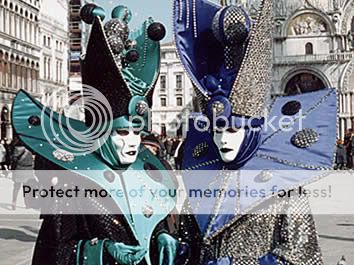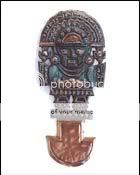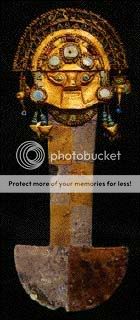THIS JOURNAL IS ON 15 FAVORITE JOURNAL LISTSHonor: 0 [ Give / Take ]
5 entries this month
The Venetian Masks11:45 Jul 23 2005
Times Read: 625

Story Behind the Masks
In response to many requests we’ve received for information concerning
the masks we import from Venice, we’ve put together some information for your enjoyment, some of it fact....some myth....and some of our thoughts.
Venice...the mask of Italy
Carnevale
Carnevale is not merely entertainment but is deeply rooted in history
and culture. It came into its own during the eighteenth century. Europe
regarded Venice as a kind of licentious, magical capital. A strange crowd of fire-eaters, tumblers, sellers of miracle potions and wild animal tamers appeared and performed in the squares and on bridges. The use of masks was predominant.
During this era, carnevale started shortly after Christmas and extended
to Ash Wednesday. Everyone took part in the entertainment and collective revelry, rich and poor, locals and strangers, senators and populace, all mingling together and indistinguishable beneath their masks!
By the end of that century, Venice was partially controlled by the Austrian Imperialists and masks virtually disappeared along with Carnevale when Napoleon’s troops brought an end to the Venetian Republic in 1797.
In the 1980’s, Venice revived Carnevale and it continues to this day as
a spectacular event culminating on Martedi Grasso or Mardi Gras (Shrove
Tuesday).
Commedia deli Arte
Comparatively little is known about the true Italian comedy, the Commedia deli Arte before the Renaissance and the seventeenth century
however, at that time, we discover the Commedia existing alongside the
regular or legitimate theatre.
As we know, the theatre has always been one of the great passions of
the Italian people... the theatre is so popular that most of the working men deprive themselves of food in order to have the wherewithal to go to the play... It has also been noted that the vitality, influence and success of the commedia were due to the unusual and special qualities of its actors who were skilled in impromptu theatre. Since the technique of improvising required these rare gifts, an actor of the Italian comedy was obliged to be, among other things, an acrobat, dancer, psychologist, orator and a man of imagination, possessing thorough knowledge of human nature, so that he could adequately bring alive the character he interpreted.
"The improviser is, in truth, the only complete actor."
The Venetian Mask
The profession of mask making was founded in Venice, Italy in April 1436 by the Masters of the Painters Guild.
These masks are the work of Franco, one of the few master mask makers in Venice. The artist presses papier mache into molds and coats the mask with plaster. He then applies a second layer of papier mache,
lines the back of the mask with gauze and places it in an oven to stiffen it. Finally, he trims the edges and hand paints the result. This tradition of hand crafting masks has remained unchanged for hundreds of years.
The mask and costume create illusions...by putting everyone on the same level...rich and poor...lovely and ugly, etc. Historically, masks were worn for several months of the year because they represented a kind of loss of identity for the person.
Masks are the hallmark of Carnevale in Venice. The practice of wearing
masks for disguise reached its zenith in the 18th century when Venetians of different social classes used Carnevale as an excuse for promiscuity.
Masks
Most of the performers of the Commedia dell Arte wore traditional masks and costumes peculiar to the various characters they were to portray.
Bauta
This mask, typical of the Venetian tradition was considered an ideal
disguise for those wishing to be incognito. The costume was an ample, all enveloping black silk cloak and a cape of black lace hung from a black tri-cornered hat covering the top torso of the person. The mask was fixed to the hat and because of its shape, it allowed the wearer to eat, drink and breathe freely and provided total anonymity to either a man or woman.
Arlecchino
Arlecchino’s mask has very ancient origins and has undergone many changes over the ages. Probably from medieval times, he represents the
evolution of jester devils. His mask typically shows prominent cheekbones, a flattened upturned nose and hollowed cheeks.
This man servant is a lazy-bones but also a busy body, a mixture of cunning and ingeniousness, of awkwardness and grace. His costume is
made up of a jacket with multicolored patches and a belt from which is
suspended a long loaf of bread (to defend his master).
Pantalone
Pantalone’s mask had an accentuated hooked nose and a beetling,
furrowed brow. A curious pointed beard would sprout out from under the
mask. Completing the picture of the first old man called the Magnifico, his red costume consisted of long tights, a wool cap, long black cape and on his feet, black pumps.
Pantalone was the rich, old merchant. Old, however, did not mean having one foot in the grave in Renaissance Italy. Perruci liked to describe him as a puer centum ann onum (a hundred year old boy) precisely because despite aches and pains, this character at times gave his audience a breath of youth, and he was still capable of making advances to a young woman.
II Capitano
The mask of II Capitano represented all that is diabolic and animal-like. His mask is adorned with a huge nose and scowling brow.
Known as Capitan Fracasso (fright) or Capitan Spaventa (smash), he was
a roistering, bragging soldier of fortune. His costume was in garishly bright colors and he wore a plumed hat. He carried a fearful sword with
its inevitable rust and spider webs, the only trophy he had to show for the blood thirsty duels he supposedly had fought.
Pierrot
The original character, Peppe Nappa, dates back to the second half of
the 16th century. He was originally a valet but he differs radically from other valets or servants of the Commedia. He is a young personable and trustworthy individual who could be a charming lover if necessary. He did not wear a mask and had a heavily powdered face to give him great play of facial expression.
As time progressed, a chalky white mask was developed for the player,
Pierrot.
Pulcinella
Commedia deli Arte character, par excellence, this character lives on as the master clown of all times. His mask, with its beaked nose and mole combined with his white costume tend to make him look rather like a rooster. Supposedly, Pulcinella originated as a broken down castrato who had been incubated by a hen.
Zanni
These ancient masks from the Commedia dell Arte personify the servants of the masters. They are the heirs of mountain dwellers who emigrated to Venice to find jobs. The Zanni usually wear large coats, baggy trousers, brimmed hats adorned with plumes and animals’ tails. The
masks have animal-bird like features with huge hooked noses of varying
lengths.
Columbina
One of the first women to be accepted in to the theatre, Columbina was reluctant to cover her lovely features with a mask and so the small
half-mask, or loup, was designed especially for her. She was the mischievous and charming serving wench of the commedia...a comic
character who was not always a mirror of virtue. Her name lives on to
this day as all half masks are referred to as Columbina masks.
II Medico Della Peste
In the terrible plague of 1630, it was written that doctors put on a peculiar costume. The black full cape was made of a waxed canvas so that infectious vapouri could not pass through. He wore a large brimmed encompassing hat and white gloves. Further protection came in the mask with its eyeglasses and its huge beak stuffed with disinfectant herbs. This, then, is not a carnival costume but rather a symbol of the fatal epidemic in Venice.
Fantasy Masks
Carnivale in medieval times and later during the Renaissance transformed the town of Venice into one vast theatre with room for each
person to act out his chosen role without restraint. Thanks to the rebirth of Carnivale in the later part of the twentieth century, the skilled crafts of the master mask-maker that seemed destined to die out now flourishes anew. Creating beautiful illusions with feathers, fabrics, and jewels, the fantasy continues.
Venice...the mask of Italy
Inca Figure From Peru08:37 Jul 11 2005
Times Read: 641

Used in ceremonial sacrifices of people pre-inca cultures in the Peruvian Coastal Region.
This one is attributed to the "Mochica-Chimu" cultures and they are not exactly inca.
This was used as a knife called "Tumi" for sacrifices, the lower part of the piece has a kind of a very sharp round knife.
To carry a Tumi or to hang on a wall means good luck and has become a symbol used in the Peruvian Tourism Publicity.
The Inca worshipped nature gods, and included fetishism, and animism.
Inti, the sun god, was the leader of the pack, with Viracocha, a culture hero and god of creation, and Apu, the rain god, followed close behind.
The Inca religion was very much a part of every day life, and was integrated into the state. That means that worship of the sun god was required of the emperor's subjects.
Inca rituals included sacrifice of humans and animals.
Here's an intimidating detail: children were feasted before sacrificed so that they wouldn't come to the gods crying and hungry! (I bet Thanksgiving dinner is sounding a little less appetizing right now).


Tumi
Couteau sacrificiel, le plus souvent en or, utilisé dans les cultures Mochica et Lambayeque.
Dans l'un des plus beaux exemplaires qui ait été conservé (le tumi de Lambayeque du Museo de Oro de Lima), le manche est une magnifique pièce d'orfèvrerie sertie de pierres précieuses à l'effigie du dieu Naymlap (ci-contre).
La lame est courte et arrondie en forme de demi-lune.
Ezekiel 25:17
11:59 Jul 03 2005
Times Read: 658
The path of the righteous man is beset on all sides by the inequities
of the selfish and the tyranny of evil men.
Blessed is he who, in thename of charity and good will,
shepherds the weak through the valley of the Darkness.
For he is truly his brother's keeper and the finder of lost children.
And I will strike down upon thee with great vengeance
and furious anger those who attempt to poison and destroy my brothers.
And you will know I am the Lord when I lay my vengeance upon you.
Other pick up line....................10:46 Jul 03 2005
Times Read: 659
I want to

the Rome's outta you!
Just a pick up line...............10:44 Jul 03 2005
Times Read: 660
You are so damn

You might burn my lips with a kiss!
RECENT MEMBER PAGES
Superior Sire (140)

Superior Sire (140)

Superior Sire (140)
REAL VAMPIRES LOVE VAMPIRE RAVE
Vampire Rave is a member of
Page generated in 0.0579 seconds.











COMMENTS
-